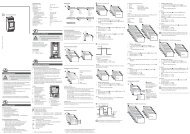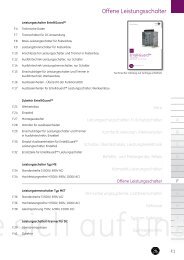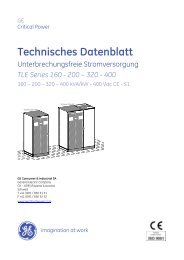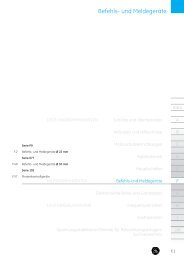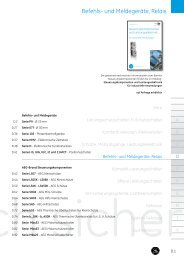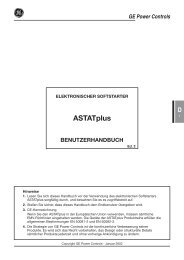GE Consumer & Industrial - G E Power Controls
GE Consumer & Industrial - G E Power Controls
GE Consumer & Industrial - G E Power Controls
Create successful ePaper yourself
Turn your PDF publications into a flip-book with our unique Google optimized e-Paper software.
1. Warnings<br />
2. General usage conditions<br />
2.1 Transportation and storing<br />
Warnings:<br />
During operation, electrical equipment carries<br />
dangerous voltages. In addition, circuit breaker<br />
emits hot, ionized gases when switching<br />
currents, especially short circuit currents.<br />
Installing, commissioning, maintaining, changing<br />
or refitting of this equipment must be carried out<br />
only by qualified and suitably trained personnel<br />
and under strict observation of national and<br />
international applicable safety regulations.<br />
During their operation, circuit breakers must be<br />
equipped with appropriately fitted covers, e.g. in<br />
suitable enclosures or panel boards. Safety<br />
distances must be preserved. Suitably trained<br />
service personnel shall only carry out certain<br />
works.<br />
Non-compliance with these warnings may result<br />
in death, and/or severe physical damage and<br />
extensive damage to equipment.<br />
Prior to carrying out maintenance, inspection or<br />
checks, the circuit breaker must be open, the<br />
both terminals must be grounded, the circuit<br />
breaker must be switched off and the control<br />
plugs removed.<br />
Manual activation of the breaker while energized<br />
is forbidden. Manual activation must only be<br />
used for maintenance and inspection purposes,<br />
when breaker power is off and grounded.<br />
The circuit breaker consists of high energy<br />
moving components. Do not touch the circuit<br />
breaker while it is being switched ON (closing) or<br />
OFF (opening). There is a high risk of major injury.<br />
The control circuits may include capacitor banks,<br />
which can be charged with dangerous voltages.<br />
Work on this section must be carried out<br />
carefully.<br />
<br />
<br />
<br />
<br />
<br />
<br />
<br />
<br />
<br />
<br />
<br />
<br />
The breaker is transported on wooden palette. It is fixed<br />
by shrunken plastic film. A cardboard box covers the<br />
breaker on the palette. Truck, railway, airplane and ship<br />
transport is possible. In case of sea transport, special<br />
protection against salty and humid environment is<br />
provided.<br />
The circuit breaker must always be transported to the<br />
installation site vertically and fully packed. The packaging<br />
protects the device against damage and dust; it should<br />
only be removed prior to installation.<br />
If the packaging is damaged, the breaker and the arc<br />
chute must be inspected for damage. Ensure that all<br />
packaging materials have been carefully removed prior to<br />
breaker installation.<br />
For handling the unpacked breaker use canvas slings and<br />
position them below the closing drive (a) and below the<br />
lower terminal (b) [Fig. 1].<br />
Fig. 1 Handling the breaker<br />
WARNING: Breaker and arc chute must be transported<br />
separately. Never handle the breaker with arc chute<br />
installed at!<br />
Take care that the bottom isolation plate of the unpacked<br />
breaker is not damaged during handling. Do not push the<br />
breaker back and forth on any rough surface.<br />
The breaker’s weight, including arc chute is listed in Table<br />
1, page 13. Arc chute’s weight is ca. 30 kG (66 lb) for “1x_”<br />
type, and ca. 60 kG (132 lb) for “2x_” type<br />
WARNING:<br />
Store in original packaging!<br />
Do not store outdoors!<br />
Use protection against crush and blow!<br />
Do not store the breaker in a damp area!<br />
Storing temperature-range –25 °C…+55 °C!<br />
4 Design and specifications are subject to change without notice S47183R01E06 2012-11-21





